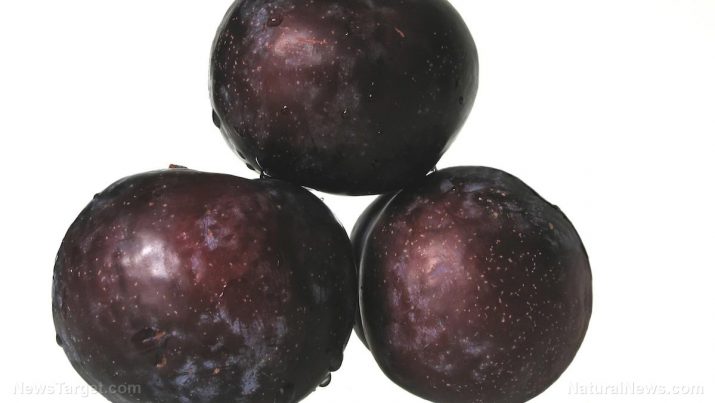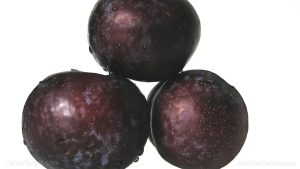
Plums – sources, health benefits, nutrients, uses and constituents at NaturalPedia.com
Wednesday, June 21, 2017 by Earl Garcia
http://www.naturalpedia.com/plums-sources-health-benefits-nutrients-uses-and-constituents-at-naturalpedia-com.html

Plums are known for their sweet flavor and fragrant aroma. The fruits belong to the Prunus plant family, which includes peaches, nectarine, damson, and almonds. Plums are considered drupes, or fruits containing hard stones that protect the seeds. According to WHFoods.com, plum season comes in May and extends up to October. On the other hand, the equally sweet and nutritious dried plums are available year round.
List of known nutrients
Plums are among the most nutritious fruits that are packed with important vitamins and minerals that keep a number of diseases at bay. An article in Nutrition-and-You.com listed the essential nutrients found in plums that include:
- Beta-Carotein
- Calcium
- Carbohydrates
- Copper
- Dietary fiber
- Folates
- Iron
- Isatin
- Lutein
- Magnesium
- Manganese
- Niacin
- Pantothenic acid
- Phosphorus
- Potassium
- Protein
- Pyridoxine
- Riboflavin
- Selenium
- Sodium
- Sorbitol
- Thiamin
- Vitamin A
- Vitamin C
- Vitamin E
- Vitamin K
- Zeaxanthin
- Zinc
Medicinal uses for plums
Plums are packed with powerful antioxidants that help stave off certain diseases. Epicatechin, a compound found in plums, is known to mitigate the growth and proliferation of malignant cancer cells. Likewise, the compound is shown to induce apoptosis (cell death) in human hepatocellular carcinoma or liver cancer cells. Plums are also a rich source of chlorogenic acid and neo-chlorogenic acids that help keep breast cancer in check. The high antocyanin content in plums are found to eliminate free radicals, which in turn reduces the risk of gastrointestinal and respiratory tract cancers.
These fruits promote heart health and the overall circulatory system. On the other hand, the plums’ high potassium content regulates heart rate and blood pressure. This lowers the risk of atherosclerosis, high blood pressure, stroke, and coronary heart disease.
Plums are known to promote digestive health too. The fruits are rich in dietary fiber that regulate the digestive system and remove toxins. The sorbitol and isatin compounds in plums are found to act as natural laxatives that ease bowel movement and prevent constipation. The fruit’s high fiber content makes it an ideal staple in weight loss. The fruit also contains diuretic and detoxifying properties that eliminate toxins from the body.
In addition, plums are known to have a low glycemic index, which makes the fruit essential in diabetes management. The phytonutrients found in plums are shown to regulate glucose release after meals and prevent sudden spikes in blood sugar levels. The fruit’s high vitamin C levels are also beneficial to the immune system, while its rich folate content supports fetal development during pregnancy. Likewise, plums are notably beneficial to the brain and the nervous system. The fruit’s rich flavonoid content is known to stave off cognitive impairment and improve the nervous system’s function.
Furthermore, plums are known to promote electrolyte balance, skin care, bone health, and cellular health. The fruit is also known to prevent anxiety, eye diseases, and age-related conditions.
Body systems supported by plums
Plums are beneficial for the heart and the circulatory, digestive, and immune systems. Likewise, the fruit supports the brain and the nervous system, the skin, and bones and eyes.
Ways to use plums
Being sweet and fragrant, plums are popular fruits used in many desserts including pies, tarts, and cakes. Plums are also popular fruit fare for coolers such as sorbet and ice cream. SeriousEats.com has compiled various recipes that involve plums.
Where to learn more
- Dried plums shown to be effective against fractures and osteoporosis
- Dried Plums: An Effective Natural Alternative to Synthetic Preservatives
- Polyphenols in Dried Plums Reduce Risk of Osteoporosis
- Five ways delicious organic plums can benefit your health
- Replace Empty Calories with Healthy Asian Snacks
Summary
Plums prevent cardiovascular diseases, diabetes, and certain types of cancer.
Plums keep constipation, cognitive impairment, and eye diseases at bay.
The fruit benefits the heart and the circulatory, digestive, and the immune systems.
The fruit supports the brain and the nervous system, the skin, and bones and eyes.
Sources include:
Tagged Under: Tags: Plums






